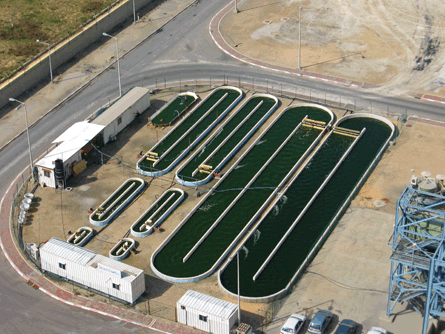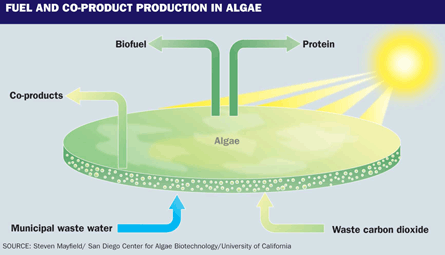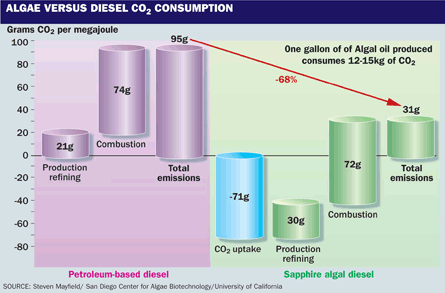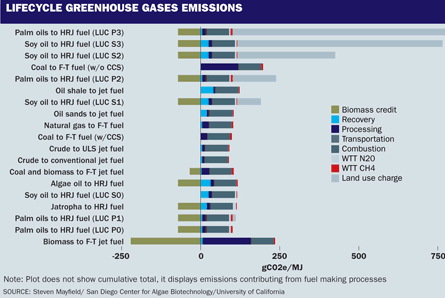Could pond organisms really power the airliners of tomorrow? After much hype over algae-based fuels, the players in this young industry are beginning to co-operate and analyse the business risks involved in turning a potentially world-changing biotechnology into commercial products.
However, despite enthusiastic backing from major aerospace players and from the petroleum industry itself, many feel that what is still missing is political leadership in terms of determining research priorities and grants, particularly in the US.
There are any number of methods to manipulate algae - the world's most diverse and plentiful group of organisms - into oil. But doing it on an industrial scale, with sufficient efficiencies and volumes to make it profitable, could still be a decade away.
Single cells of algae hold enormous energy content and grow where nothing else will, even feeding off wastewater. Farmland is not needed for algae, which contain the most nutrients of any plant.
 |
|---|
© SeambioticOpen pond systems nurture algae favourable to the local environment |
The reason dietary supplements are already profitable is that most algae are 25% protein and 50% oil. Some crops mature in as little as seven days and, once the research matures as well, algae could yield 60,000 litres of oil per hectare (39,000USgal per acre) each year. Soybeans yield 400 litres/ha a year and jatropha can offer 2,000 litres/ha a year.
The potential for sales of $12,532 per hectare each year is real, says Steve Mayfield, associate dean of the Scripps Research Institute. Even opium is not as profitable, he explains. "The only thing that compares is high-grade marijuana."
So what holds algae back? Mayfield says it is a lack of research, comparing the 4,611 papers written on a leading algae strain to 220,222 on E Coli. But each year the litres of oil per hectare increase, while the costs of producing those litres decrease.
"It is going to be a real part of our energy future and have a much cleaner lifecycle than today's fuels," says Billy Glover, director of environmental strategy for Boeing Commercial Airplanes. "At the same time, we're going to see a lot of failed attempts," he adds.
Glover is 18 months into his two-year term as chairman of the Algal Biomass Organization (ABO), one of several trade groups. Commercial membership of the ABO has doubled over the past year, he says, with some members exploring algae as food or chemical source, and many others trying to compete with petroleum.
The day algae fuels are cheap enough is eight to 10 years away, predict Glover and many others, but at the third annual Algal Biomass Summit in San Diego, US, in October, Glover added: "I've talked with some companies here who think they'll make it in five years, and I won't be surprised if they do."
More than 800 experts were at the summit to build bridges across a segmented industry. Transparency will expand, Glover expects, and will add facts to the hype around algae.
Eager for solutions and commercial fuels, most of ABO's eight top sponsors are from aerospace: Air New Zealand, Boeing, UOP, Raytheon and Virgin Atlantic.
"We're facilitating. We're a catalyst," says Glover - and that role includes quiet Boeing support of at least a dozen algae innovators. "Our goal is not to establish a business partnership. It's really to understand the technology and connect parties together, the bits and pieces people are working on," he says. "We're not trying to pick the winner."
Boeing did announce in October that it would partner Honeywell's UOP and the Airports and Auxiliary Services agency of Mexico's Ministry of Communications and Transport to research biofuel feedstocks in Mexico, including algae.
OVERLAPPING USES
Enzymes produced from certain algae will help produce cellulosic ethanol from corn stalks and forest wastes, while key proteins will bring breakthroughs to food and medicine. Every cell absorbs carbon dioxide and could push algae's carbon footprint below zero.
Although experts disagree on how feasible it will be, algae could abate CO2 emitted by powerplants and the Fischer-Tropsch process, which is already converting natural gas and coal into barrels of jet fuel, but will be a major source of industrial CO2. Already gas-to-liquid and coal-to-liquid fuels have blazed trails to new fuel qualifications defined by the UK Ministry of Defence and ASTM International. Algae will follow those trails.
 |
|---|
"This is not just a solution for the aircraft itself, but also the existing infrastructure," says Paul Nash, head of new energies at Airbus. "This will hopefully lead to local jobs for local people," he adds.
Before algae-based fuels are ready for commercial use, however, Nash says the field needs common definitions for oil production and land needs, and to identify the environments with the best conditions and ample CO2.
"In reality, these are still small companies and still far away from a commercial size," he says.
Nash gives the European Alpha-Bird and the Sustainable Way for Alternative Fuel and Energy in Aviation (SWAFEA) research programmes as examples of, "where we look for the most promising fuels, with appropriate test of the fuel itself, the relevant aircraft systems and the supporting infrastructure".
Airbus would welcome more government funding to join the fuels research that is now under way.
The European Union is investing €2.7 billion ($4 billion) into algae research over seven years, and is including algae for the first time in the 2010 calls for its Seventh Framework Programme. Individual countries, particularly in western Europe, are supporting research and expansion as well.
 |
|---|
Nevertheless, some government-backed programmes have failed to live up to expectations. Japan's Research for Innovative Technology of the Earth programme spent $100 million studying closed algae systems, but ultimately gave up on it. In 1996 the US closed its Aquatic Species Program, which led research over three decades at two 1,000m2 (10,765ft2) open pond systems before concluding that the technology was too expensive for large-scale production.
Today, many US policies block algae research from earning grants. Parity for algae-based biofuels is included in the chairman's mark of the Clean Energy Jobs and American Power Act, which Senator Barbara Boxer of California hopes will become law.
As to when the US Department of Energy will release a technical and economical analysis on algae, Valerie Sarisky-Reed, conversion team leader of the DoE's Biomass Office, says: "I envisage that at the end of the funding cycle for 2010 we'll have a better handle on that and at that time we will set projections that will be in our budget and help drive our research."
Congress has already allocated $35 million for algae research, she says, and algae pilot plants can apply for a share of the $480 million in the US Economic Recovery Act.
In July, the US Energy & Environmental Research Center at the University of North Dakota was given a subcontract by Science Applications International to help produce military JP-8 jet fuel from algae using up to $25 million of DARPA funds won in January.
DARPA's BioFuels - Cellulosic and Algal Feedstocks programme that was established in 2007 will test the fuel, and that of General Atomics, which received its own $19.9 million DARPA contract in January to focus on increased yield per hectare. One aim is to push the cost of algae oil from $7.9/litre to $0.52/litre.
Private investment took a major leap in July, when ExxonMobil announced a plan to spend $600 million, with half going to Synthetic Genomics to develop biofuels from algae.
One of the other aviation innovators is Raytheon, which is working with A2BE Carbon Capture to raise industrial-scale algae using CO2 flue gas as a feeder to produce biodiesel, animal feed, fertiliser and speciality chemicals.
 |
|---|
HR Biopetroleum has had almost 20 years to puzzle over these problems, which may be one reason Royal Dutch Shell has partnered with it to form Cellana and build massive algae ponds in Hawaii.
The venture is a contender to be the largest biofuel producer when its commercial plant starts operating next year and if plans for a 20,000Ha plant hold true for 2012.
So-called open systems stand exposed to the elements and nurture algae favourable to the local environment. On average, 35° north and south of the equator are the boundaries of adequate temperature and sunlight. Much can be done to stimulate growth in these low-cost simple systems, but not as much as is possible in the more expensive closed systems.
These can cover just as many hectares, but are sealed in plastic, glass or bags and offer extensive control options. Numerous innovative designs aim to mimic the low costs of open ponds with the efficiency and enhanced production of closed systems.
In both systems, the algae must be dried, currently one of the most expensive stages, before the oil can be extracted and converted from hydrocarbons into fuel.
Common academic ground on best performing the many steps has been a goal of the US Air Force Office of Scientific Research for four years. Programme manager Walter Kozumbo's total annual budget is $8 million, and of that $2 million is spent on building the literature base and developing new algal genetic tool and transformation vectors.
"Our niche is to create the knowledge and put it into the open literature so everybody can access it," Kozumbo says.
Although the research is fractured today, eventually everyone will be able to ride an airliner powered by algae.
Source: Flight International























